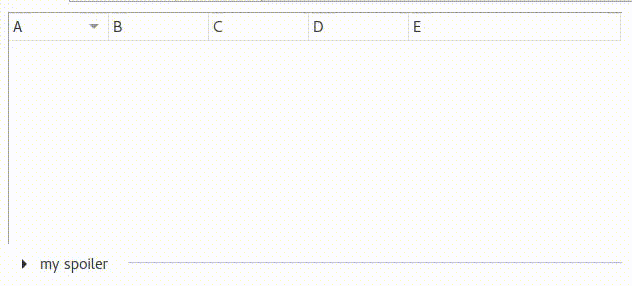How to make an expandable/collapsable section widget in Qt
I stumbled upon the same problem and solved it by implementing the collapsible widget as a QScrollArea whose maximum height is animated by a QPropertyAnimation.
But since I don't use QDesigner, I can't tell you if it works there.
I still have one problem: Instead of only expanding towards the bottom direction, the collapsible widget can expand towards the top and bottom. This can cause widgets located above it to shrink if they haven't reached their minimum height, yet. But this is really a detail compared to the fact that we have to build this thing ourselves…
Spoiler.h
#include <QFrame>
#include <QGridLayout>
#include <QParallelAnimationGroup>
#include <QScrollArea>
#include <QToolButton>
#include <QWidget>
class Spoiler : public QWidget {
Q_OBJECT
private:
QGridLayout mainLayout;
QToolButton toggleButton;
QFrame headerLine;
QParallelAnimationGroup toggleAnimation;
QScrollArea contentArea;
int animationDuration{300};
public:
explicit Spoiler(const QString & title = "", const int animationDuration = 300, QWidget *parent = 0);
void setContentLayout(QLayout & contentLayout);
};
Spoiler.cpp
#include <QPropertyAnimation>
#include "Spoiler.h"
Spoiler::Spoiler(const QString & title, const int animationDuration, QWidget *parent) : QWidget(parent), animationDuration(animationDuration) {
toggleButton.setStyleSheet("QToolButton { border: none; }");
toggleButton.setToolButtonStyle(Qt::ToolButtonTextBesideIcon);
toggleButton.setArrowType(Qt::ArrowType::RightArrow);
toggleButton.setText(title);
toggleButton.setCheckable(true);
toggleButton.setChecked(false);
headerLine.setFrameShape(QFrame::HLine);
headerLine.setFrameShadow(QFrame::Sunken);
headerLine.setSizePolicy(QSizePolicy::Expanding, QSizePolicy::Maximum);
contentArea.setStyleSheet("QScrollArea { background-color: white; border: none; }");
contentArea.setSizePolicy(QSizePolicy::Expanding, QSizePolicy::Fixed);
// start out collapsed
contentArea.setMaximumHeight(0);
contentArea.setMinimumHeight(0);
// let the entire widget grow and shrink with its content
toggleAnimation.addAnimation(new QPropertyAnimation(this, "minimumHeight"));
toggleAnimation.addAnimation(new QPropertyAnimation(this, "maximumHeight"));
toggleAnimation.addAnimation(new QPropertyAnimation(&contentArea, "maximumHeight"));
// don't waste space
mainLayout.setVerticalSpacing(0);
mainLayout.setContentsMargins(0, 0, 0, 0);
int row = 0;
mainLayout.addWidget(&toggleButton, row, 0, 1, 1, Qt::AlignLeft);
mainLayout.addWidget(&headerLine, row++, 2, 1, 1);
mainLayout.addWidget(&contentArea, row, 0, 1, 3);
setLayout(&mainLayout);
QObject::connect(&toggleButton, &QToolButton::clicked, [this](const bool checked) {
toggleButton.setArrowType(checked ? Qt::ArrowType::DownArrow : Qt::ArrowType::RightArrow);
toggleAnimation.setDirection(checked ? QAbstractAnimation::Forward : QAbstractAnimation::Backward);
toggleAnimation.start();
});
}
void Spoiler::setContentLayout(QLayout & contentLayout) {
delete contentArea.layout();
contentArea.setLayout(&contentLayout);
const auto collapsedHeight = sizeHint().height() - contentArea.maximumHeight();
auto contentHeight = contentLayout.sizeHint().height();
for (int i = 0; i < toggleAnimation.animationCount() - 1; ++i) {
QPropertyAnimation * spoilerAnimation = static_cast<QPropertyAnimation *>(toggleAnimation.animationAt(i));
spoilerAnimation->setDuration(animationDuration);
spoilerAnimation->setStartValue(collapsedHeight);
spoilerAnimation->setEndValue(collapsedHeight + contentHeight);
}
QPropertyAnimation * contentAnimation = static_cast<QPropertyAnimation *>(toggleAnimation.animationAt(toggleAnimation.animationCount() - 1));
contentAnimation->setDuration(animationDuration);
contentAnimation->setStartValue(0);
contentAnimation->setEndValue(contentHeight);
}
How to use it:
…
auto * anyLayout = new QVBoxLayout();
anyLayout->addWidget(…);
…
Spoiler spoiler;
spoiler.setContentLayout(*anyLayout);
…

I know this is not a good way to answer a question, just with a link, but I think this blog post is quite relevant:
http://www.fancyaddress.com/blog/qt-2/create-something-like-the-widget-box-as-in-the-qt-designer/
It is based on QTreeWidget, and uses its expand / collapse features, which are already implemented. It explains how widgets can be added to the tree widget items, and how to add a button to use for collapse / expand them.
Of course, all the credit goes for the post author.
Even though this is old I found this thread helpful. However, I'm working in python, so I had to convert the C++ code. Just in case anyone is looking for a python version of x squared's solution. Here is my port:
from PyQt4 import QtCore, QtGui
class Spoiler(QtGui.QWidget):
def __init__(self, parent=None, title='', animationDuration=300):
"""
References:
# Adapted from c++ version
http://stackoverflow.com/questions/32476006/how-to-make-an-expandable-collapsable-section-widget-in-qt
"""
super(Spoiler, self).__init__(parent=parent)
self.animationDuration = animationDuration
self.toggleAnimation = QtCore.QParallelAnimationGroup()
self.contentArea = QtGui.QScrollArea()
self.headerLine = QtGui.QFrame()
self.toggleButton = QtGui.QToolButton()
self.mainLayout = QtGui.QGridLayout()
toggleButton = self.toggleButton
toggleButton.setStyleSheet("QToolButton { border: none; }")
toggleButton.setToolButtonStyle(QtCore.Qt.ToolButtonTextBesideIcon)
toggleButton.setArrowType(QtCore.Qt.RightArrow)
toggleButton.setText(str(title))
toggleButton.setCheckable(True)
toggleButton.setChecked(False)
headerLine = self.headerLine
headerLine.setFrameShape(QtGui.QFrame.HLine)
headerLine.setFrameShadow(QtGui.QFrame.Sunken)
headerLine.setSizePolicy(QtGui.QSizePolicy.Expanding, QtGui.QSizePolicy.Maximum)
self.contentArea.setStyleSheet("QScrollArea { background-color: white; border: none; }")
self.contentArea.setSizePolicy(QtGui.QSizePolicy.Expanding, QtGui.QSizePolicy.Fixed)
# start out collapsed
self.contentArea.setMaximumHeight(0)
self.contentArea.setMinimumHeight(0)
# let the entire widget grow and shrink with its content
toggleAnimation = self.toggleAnimation
toggleAnimation.addAnimation(QtCore.QPropertyAnimation(self, b"minimumHeight"))
toggleAnimation.addAnimation(QtCore.QPropertyAnimation(self, b"maximumHeight"))
toggleAnimation.addAnimation(QtCore.QPropertyAnimation(self.contentArea, b"maximumHeight"))
# don't waste space
mainLayout = self.mainLayout
mainLayout.setVerticalSpacing(0)
mainLayout.setContentsMargins(0, 0, 0, 0)
row = 0
mainLayout.addWidget(self.toggleButton, row, 0, 1, 1, QtCore.Qt.AlignLeft)
mainLayout.addWidget(self.headerLine, row, 2, 1, 1)
row += 1
mainLayout.addWidget(self.contentArea, row, 0, 1, 3)
self.setLayout(self.mainLayout)
def start_animation(checked):
arrow_type = QtCore.Qt.DownArrow if checked else QtCore.Qt.RightArrow
direction = QtCore.QAbstractAnimation.Forward if checked else QtCore.QAbstractAnimation.Backward
toggleButton.setArrowType(arrow_type)
self.toggleAnimation.setDirection(direction)
self.toggleAnimation.start()
self.toggleButton.clicked.connect(start_animation)
def setContentLayout(self, contentLayout):
# Not sure if this is equivalent to self.contentArea.destroy()
self.contentArea.destroy()
self.contentArea.setLayout(contentLayout)
collapsedHeight = self.sizeHint().height() - self.contentArea.maximumHeight()
contentHeight = contentLayout.sizeHint().height()
for i in range(self.toggleAnimation.animationCount()-1):
spoilerAnimation = self.toggleAnimation.animationAt(i)
spoilerAnimation.setDuration(self.animationDuration)
spoilerAnimation.setStartValue(collapsedHeight)
spoilerAnimation.setEndValue(collapsedHeight + contentHeight)
contentAnimation = self.toggleAnimation.animationAt(self.toggleAnimation.animationCount() - 1)
contentAnimation.setDuration(self.animationDuration)
contentAnimation.setStartValue(0)
contentAnimation.setEndValue(contentHeight)
I have dug through the excellent pointer provided by @LoPiTal and converted it to PyQt5 (Python3). I think it's very elegant.
In case anyone is looking for a PyQt-solution, here's my code:
import sys
from PyQt5.QtWidgets import (QPushButton, QDialog, QTreeWidget,
QTreeWidgetItem, QVBoxLayout,
QHBoxLayout, QFrame, QLabel,
QApplication)
class SectionExpandButton(QPushButton):
"""a QPushbutton that can expand or collapse its section
"""
def __init__(self, item, text = "", parent = None):
super().__init__(text, parent)
self.section = item
self.clicked.connect(self.on_clicked)
def on_clicked(self):
"""toggle expand/collapse of section by clicking
"""
if self.section.isExpanded():
self.section.setExpanded(False)
else:
self.section.setExpanded(True)
class CollapsibleDialog(QDialog):
"""a dialog to which collapsible sections can be added;
subclass and reimplement define_sections() to define sections and
add them as (title, widget) tuples to self.sections
"""
def __init__(self):
super().__init__()
self.tree = QTreeWidget()
self.tree.setHeaderHidden(True)
layout = QVBoxLayout()
layout.addWidget(self.tree)
self.setLayout(layout)
self.tree.setIndentation(0)
self.sections = []
self.define_sections()
self.add_sections()
def add_sections(self):
"""adds a collapsible sections for every
(title, widget) tuple in self.sections
"""
for (title, widget) in self.sections:
button1 = self.add_button(title)
section1 = self.add_widget(button1, widget)
button1.addChild(section1)
def define_sections(self):
"""reimplement this to define all your sections
and add them as (title, widget) tuples to self.sections
"""
widget = QFrame(self.tree)
layout = QHBoxLayout(widget)
layout.addWidget(QLabel("Bla"))
layout.addWidget(QLabel("Blubb"))
title = "Section 1"
self.sections.append((title, widget))
def add_button(self, title):
"""creates a QTreeWidgetItem containing a button
to expand or collapse its section
"""
item = QTreeWidgetItem()
self.tree.addTopLevelItem(item)
self.tree.setItemWidget(item, 0, SectionExpandButton(item, text = title))
return item
def add_widget(self, button, widget):
"""creates a QWidgetItem containing the widget,
as child of the button-QWidgetItem
"""
section = QTreeWidgetItem(button)
section.setDisabled(True)
self.tree.setItemWidget(section, 0, widget)
return section
if __name__ == "__main__":
app = QApplication(sys.argv)
window = CollapsibleDialog()
window.show()
sys.exit(app.exec_())